| Number 63, November 2004 |
 |
 Perchlorate treatment promising for double duty
Perchlorate treatment promising for double duty
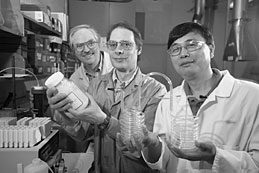
|
| Baohau Gu (right) headed development of the perchlorate treatment system. Also shown are Peter Bonnesen (center) and Gilbert Brown. |
By cleaning up environmental contaminanation, helping to reveal its source
An award-winning system developed at ORNL to clean up perchlorate pollution is now also helping scientists determine whether the contamination is natural or man-made.
This latter application could be instrumental in tracking environmental perchlorate, finding its source and resolving resulting liability issues, said ORNL scientist Baohua Gu, who headed development of the treatment system.
Perchlorate, or ClO4-, disrupts the thyroid gland that regulates metabolism in adults and physical development in children and is increasingly being found in soil and water. It is used to make solid rocket propellant and explosives but also occurs naturally, as in nitrate soils from Chile used to make fertilizers, making the source sometimes difficult to trace.
Conventional treatments use tiny resin beads to trap the perchlorate, but the spent resin becomes contaminated, and disposal is costly or impractical.
The ORNL system removes and breaks down perchlorate into harmless chloride and water and recharges the resin so it can be reused many times. The process costs up to 80 percent less than conventional methods and is one of R&D Magazine’s top 100 inventions for 2004.
But Gu and ORNL colleagues Jusuke Horita and Gilbert Brown, along with others from Louisiana State University, University of Illinois and USGS have found another benefit: The process of removing perchlorate also purifies it, allowing the scientists to isolate trace quantities and examine the compound more closely than ever before.
Using isotopic analysis, they compared naturally occurring perchlorate from Chile’s Atacama Desert to synthetic or manufactured samples and found the natural type had a much higher value of the oxygen-17 isotope (an oxygen atom with 8 protons and 9 neutrons in the nucleus) but a lower chlorine-37 value (a chlorine atom with 17 protons and 20 neutrons in the nucleus).
A report on the study appeared in a recent edition of Environmental Science and Technology, which is published by the American Chemical Society.
“Isotopic comparison of natural and non-naturally occurring perchlorate has not been feasible because of the difficulties in extracting and analyzing trace quantities of perchlorate from soil or groundwater that contain large quantities of impurities like nitrates and other salt deposits,” Gu said. “Our findings show that the ORNL treatment system provides a tool for the identification and forensics of perchlorate contamination in the environment.”
ORNL has licensed the resin technology to the Purolite company and the regeneration and recovery technology to Calgon Carbon Corporation. The system also is being tested at two contaminated sites in California, and Gu recently presented findings from those tests at meetings with municipal water utilities and environmental remediation groups in the state.
The Environmental Protection Agency proposed one part per billion in 2002 as the legal limit for perchlorate in drinking water, but that standard is under debate, Gu explained.
“The presence of natural or atmospheric perchlorate in the environment obviously has far-reaching ramifications, ranging from public health issues to huge liabilities that could be imposed by agricultural and environmental cleanup needs,” Gu said. “It recently has been found in lettuce and milk, which begs the questions: How is it getting there and migrating through the environment? Where is the liability?
“Our technology could have a huge impact on how those questions are answered,” Gu said.—Mike Bradley
 Laboratory’s best recognized at Awards Night 2004
Laboratory’s best recognized at Awards Night 2004
More than 300 ORNL employees and
guests spent a festive evening at the Knoxville Marriott October 29 as the lab recognized outstanding staff achievements at 2004 Awards Night ceremonies.
Awards were presented to individuals and teams in the following general categories: Science and Technology, Laboratory Operations, Community Service, and Legacy Impact Contributions.
C.T. Liu’s outstanding career in the Metals and Ceramics Division was rewarded with the Director’s Award for Outstanding Individual Accomplishment in Science and Technology.
Recipients of other Director’s Awards for Outstanding Individual Accomplishment were the Networking and Computing Technologies Division’s Ann Farrar, Laboratory Operations; and the recently retired Tim Myrick, Community Service.
Director’s Awards for Outstanding Team Accomplishment were presented to two groups whose efforts resulted in laboratory successes: the National Leadership Computing Facility proposal team and the multi-organizational group that put together last year’s Council for the Advance of Science Writing New Horizons briefing.
The names of all Awards Night honorees (with winners listed before finalists) follow by category.
Outstanding Accomplishment in Science and Technology
Distinguished Engineer
John T. Shaffer. For over two decades of innovative leadership in the development and engineering of composite systems and the establishment of leading edge manufacturing techniques enabling multiple applications
Finalists: Charles Forsberg. For sustained and significant contributions in the areas of reactor safety, reactor concept development and waste management technology
Brad Nelson. For sustained technical innovations and outstanding leadership in the design and construction of experimental fusion energy research facilities
Early Career Engineering Accomplishment
Nidia C. Gallego. For exceptional potential for leadership in applied materials engineering and for exemplary early career accomplishments
Finalist: Burak Ozpineci. For excellence in engineering research on advanced power electronic device application and power system topologies in fuel cell systems that are critical to DOE’s goals of energy efficiency
Engineering Development by a Team
Carlton Ray Brittain, Kim N. Castleberry, Alfred L. Fraker, R. W. Jones, David R. Light, Jose March-Leuba, Carl W. Martin, Vickie Shannon Martin, Melissa Sherrod, Taner Uckan, Kenneth S. Weaver and R. Wesley Wysor. For the design, procurement, fabrication and shipment of the Blend Down Monitoring System, which solved a critical U.S. national security concern and ensured that a vital nonproliferation objective was met
Inventor of the Year
Stephen F. Smith. For the establishment of an intellectual property portfolio that has garnered a strong position for ORNL among national laboratories and private sector R&D organizations in the area of wireless technologies
Finalists: Meng-Dawn Cheng. For outstanding creativity in the design of a revolutionary aerosol plasma spectrometer system that can characterize airborne particles far smaller than any existing monitoring technology
Philip J. Maziasz. For development of new CF8C-Plus cast austenitic stainless steel with improved high-temperature performance based on engineered microstructure
R&D Leadership, Group Level
Sherrell R. Greene. For vision, creativity and leadership that have established ORNL as an R&D leader in the development and utilization of fission power reactors for the exploration of space
Finalists: Johney Boyd Green Jr. For innovative leadership of the Fuels and Engines Research Group
David M. Hetrick. For outstanding and exemplary leadership of the Computational Science and Engineering Division’s Modeling and Simulation Group and program development leadership
Cecil V. Parks. For sustained leadership in coordinating an integrated approach to the development and application of nuclear analysis software that has provided significant programmatic growth and recognition for ORNL
R&D Leadership, Director Level
Norbert Holtkamp. For outstanding leadership of the Accelerator Systems Division – a center of excellence for accelerator science and technology
Finalists: John F. Cooke. For outstanding leadership of the Condensed Matter Sciences Division in a time of extraordinary challenge and opportunity
Lawrence J. Satkowiak. In recognition of exceptional success in building the Nuclear Nonproliferation Program at ORNL
Early Career Scientific Accomplishment
Lætitia H. Delmau. For exceptional research, initiative and leadership and outstanding contributions to chemical separations science and technology
Finalists: Brian R. D’Urso. For exceptional leadership and innovation in the discovery of materials and surface features that exhibit super hydrophobic properties
Lianhong Gu. For groundbreaking work on the role of aerosols in the global carbon cycle processes and pioneering application of data assimilation methods in the development of improved terrestrial ecosystem carbon cycle models
Maria Varela. For exemplary application of aberration-corrected Z-contrast scanning transmission electron microscopy to materials physics
Scientific Research
Richard J. Norby. For outstanding leadership in research culminating in the publication of a seminal paper in the Proceedings of the National Academy of Sciences on the response of forest tree roots to elevated atmospheric CO2
Finalists: Gayle Stanford Painter, Paul F. Becher and Stephen J. Pennycook. For pioneering research on the development of theoretical descriptions of the behavior of additive elements in silicon nitride ceramics and their confirmation by atomic resolution imaging
Anthony Mezzacappa, David Jarvis Dean, William Raphael Hix, Hans-Thomas Janka, Karlheinz Langanke, Mathias Liebendorfer, Gabriel Martinez Pinedo, O. E. Bronson Messer, Markus Johannes Rampp and Jorge Miguel de Brito Almeida Sampiao. For discovering the importance of electron capture on heavy nuclei during supernovae explosions and for innovative theoretical work drawing both from their advanced supernovae modeling and their novel models of nuclear structure
Distinguished Scientist
C. T. Liu. For research on advanced materials, both in increasing fundamental understanding of their mechanical properties and in their application to energy systems
Finalists: Stephen J. Pennycook. For pioneering new approaches and insightful applications in the field of electron microscopy
George D. Wignall. For pioneering instrumentation development and sustained achievement in the structure of polymers through the use of small angle neutron scattering
Technical Support
Ann M. Wymore, Gene Barker, Lori L. Easter, Carmen M. Foster, Kay Houser, Lori Ann Hughes and Marilyn Kerley. For developing and optimizing the Cryopreserved Mutant Mouse Bank and establishing the intracytoplasmic sperm injection technique at ORNL for the recovery of mutant mice from cryopreserved sperm
Outstanding Accomplishment in Laboratory Operations
Administrative Support, Exempt Payroll
Debbie McCoy. For personal dedication and sustained contributions in support of the laboratory’s mission of making ORNL the world leader in advanced scientific computing
Finalists: Kimberly R. Grubb. For providing outstanding administrative support to numerous international conferences and meetings in support of DOE’s Office of Policy and International Affairs
Sandy L. Tull. For phenomenal support of the Nuclear Science and Technology Division’s hiring activity during FY 2004
Administrative Support, Nonexempt Payroll
Willena Clark Carter. For exemplary administrative support in the preparation of high-quality technical documents and for preparing SCALE 5 documentation for international release
Finalists: Brenda Darlene Hickman. For commitment and dedication to overwhelming procurement responsibilities and for her highly efficient manner in carrying out these responsibilities for the Metals and Ceramics Division
Kathy L. Johnson. For outstanding programmatic and administrative services to the Operational Testing, Evaluation, and Improvement Program
Bargaining Unit Support by a Team
Johnnie L. Norris, Robert A. Hackler and Mike Littleton. For outstanding contributions and leadership during the revitalization of the Metals and Ceramics Division’s High Bay area, which involved the upgrade, maintenance and installation of a vast array of facilities
Environment, Safety, Health and Quality
Kathy Carney, Karen Downer, Edith Jones, Susan R. C. Michaud and David D. Skipper. For supporting world class science through environmental sustainability
Integrated Safeguards and Security Management
Sheila Holbert, Nancy Holcombe, Russ Johnson, Dave Keller, W. Mark Logan, C. L. Nageotte, Randal Roberts, Randall B. Stanfield, Charlotte A. Townsend and John H. Watson. For innovative and efficient security solutions in support of laboratory programs that have enhanced the security of personnel and research efforts while promoting a principal ORNL goal of an open laboratory campus
Administrative and Operational Leadership, Group Level
Ann K. Farrar. For exemplary leadership both of her group and of significant major information technology projects that are providing a new technical framework for computer desktops at the laboratory
Finalist: Lynn Duncan. For leadership that exemplifies a very clear focus on supporting the R&D mission
Administrative and Operational Leadership, Director Level
Jimmy E. Stone. For energized leadership of the Facilities Management Division in achieving milestones in safety, customer satisfaction, diversity and productivity
Finalists: Joseph N. Herndon. For dedicated leadership in establishing the Laboratory Space Manager Program
Frank Kornegay. For balancing the SNS Project’s demands of cost, schedule and technical performance without compromising safety or environmental mandates
Operations Support by a Team
Sherri Cotter, Janet L. Dippo, Mark W. Dobbs, John R. Drake, Bob Fehling, R. J. Forbes, Gary L. Fraker, John Hensley, Nancy Holcombe, Jeffrey O. Johnson, Martha Justice, Anthony R. Medley, Daniel G. O’Connor, Mike Oliver, Steve Rose, Forrest L. Spears and D. Michael Turpin. For outstanding planning and implementation in executing personnel and laboratory moves into new facilities in the modernized East Campus
Secretarial Support
Pam Hadley. For excellent organizational skills; knowledge of job responsibilities; a friendly, team approach; and a remarkable energy level that permits accomplishing an incredible array of tasksFinalists: Jan Anderson. For sustained exceptional accomplishment in providing secretarial service, support and leadership within the Nuclear Science and Technology Division
Darlene Holt. For dedication and support to the Life Sciences Division with unparalleled enthusiasm and a “can-do” attitude
Outstanding Accomplishment in Community Service
Community Leadership
Timothy K. Jones, Angela Harris and Bruce Siefken. For sustained and exceptional volunteerism for the last three years in the Tour de Cure event, which raised funds for, and awareness of, the American Diabetes Association
Science Communicator
Jeff D. Muhs. For extraordinary success in communicating new value propositions and societal benefits of ORNL science and technology to a broad mix of stakeholders using several media venues
Finalists: Glenn O. Allgood. For effectively communicating the ORNL story of science and technology to our communities at the local, regional and national levels
Ross J. Toedte. For extraordinary ability to create a better understanding of high-performance computing research and its benefits to society through presentations to public officials, news media, lay audiences, educators and students
Volunteerism outside ORNL by an Individual
Tim Myrick. For leadership in the Red Cross Disaster Relief efforts in the wake of Hurricane Isabel and for his major time and financial commitment to the Oak Ridge High School renovation and to student scholarship programs - in short, for continuing to epitomize Team UT-Battelle’s goals of what employee involvement with the community is all about
Finalists: Reggie M. Lindsey. For dedication to, and continued advocacy for, volunteerism through the National Federation of the Blind, which has yielded many improvements in the lives of other people
Bradley S. Weil. For inspiring children to pursue careers in science and technology through volunteer work with the Tennessee FIRST LEGO League
Volunteerism within ORNL by an Individual
Lonna Cotter. For personal leadership of, and commitment to, ORNL’s participation in the 2004 Juvenile Diabetes Research Foundation Walk to Cure Diabetes
Volunteerism by a Team
Susie Kuliasha, Mylissa Buttram, Linda S. Edwards, Teresa D. Ferguson, Teresa J. Honeycutt, Debbie Hudak, Ellon Sue Human, Saylor Hummel, Deborah W. Knox, Lynn A. Kszos, Debbie McCoy, Valentina C. Moore, Jane Reno, Shirley Shugart, Karen Simonson, Pat Trentham, Sandy L. Tull and Nancy Y. Wright. For a phenomenal team effort in planning and coordinating ORNL’s first International Festival to enhance awareness of ORNL’s cultural diversity while raising $3,500 for the 2003 United Way Campaign
Legacy Impact Contributions
Rosemary Adams, Deborah S. Barnes, Gail Beyersdorf, Bill Cabage, Norma F. Cardwell, Tina C. Curry, Debra Dickerson, Karen Garrett, Nancy L. Gray, Brenda T. Hackworth, Carolyn Krause, Cindy Ross Lundy, Marilyn Z. McLaughlin, Fred Strohl and Ron Walli. For their foresight and selfless teamwork in bringing the Council for the Advancement of Science Writing (CASW) conference to Oak Ridge, thus providing a unique and lasting contribution to ORNL’s visibility in, and support by, the national mediaArthur S. Bland, Thom H. Dunning Jr., G. A. Geist, Debbie McCoy and Jeff Nichols. For crucial contributions in assembling an extraordinary group of partners and developing a winning proposal that provides DOE’s Office of Science with the nation’s most powerful open resource for capability computing
 Director’s Awards
Director’s Awards
 |
|---|
Outstanding Individual Accomplishment in Community Service
Tim Myrick. For leadership in the Red Cross Disaster Relief efforts in the wake of Hurricane Isabel and for his major time and financial commitment to the Oak Ridge High School renovation and to student scholarship programs - in short, for continuing to epitomize Team UT-Battelle’s goals of what employee involvement with the community is all about
 |
|---|
Outstanding Individual Accomplishment for Laboratory Operations
Ann K. Farrar. For exemplary leadership both of her group and of significant major information technology projects that are providing a new technical framework for computer desktops at the laboratory
 |
|---|
Outstanding Individual Accomplishment in Science and Technology
C. T. Liu. For research on advanced materials, both in increasing fundamental understanding of their mechanical properties and in their application to energy systems
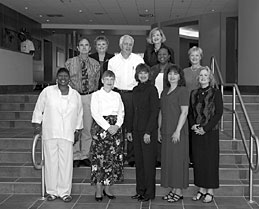 |
|---|
Outstanding Team Accomplishment
For their foresight and selfless teamwork in bringing the Council for the Advancement of Science Writing conference to Oak Ridge, thus providing a unique and lasting contribution to ORNL’s visibility in, and support by, the national media
Front row (from left): Deborah S. Barnes, Carolyn Krause, Karen Garrett, Cindy Ross Lundy, Norma F. Cardwell. Second row: Bill Cabage, Fred Strohl, Tina C. Curry, Nancy L. Gray. Back row: Brenda T. Hackworth, Marilyn Z. McLaughlin. Not pictured: Rosemary Adams, Gail Beyersdorf, Debra Dickerson, Ron Walli.
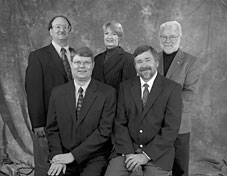 |
|---|
For crucial contributions in assembling an extraordinary group of partners and developing a winning proposal that provides DOE’s Office of Science with the nation’s most powerful open resource for capability computing
(From left) G. A. Geist, Arthur S. Bland, Debbie McCoy, Jeff Nichols, Thom H. Dunning Jr.
 Open Enrollment goes smoothly, benefits officials report
Open Enrollment goes smoothly, benefits officials report
The Open Enrollment season has come to an end. Although health-care premiums continue to rise at about five times the annual inflation rate — according to benefits consultant Watson Wyatt — UT-Battelle was able to hold the line on costs for 2005.
CIGNA’s announcement of the discontinuation of the old Option 2 (Healthsource) plan led UT-Battelle to issue a request for proposal for a replacement plan. The plan chosen, the new Point of Service (POS) plan, has basically the same features as the Option 2 plan but also includes expanded network features currently available in the Open Access plan—a pleasant surprise, some employees have said.
Many staff members elected to stay with the health plan they are in, taking advantage of the automatic default into the new plan. Most also elected to remain in the MetLife dental plan. Enrollment data show that about 475 employees selected the new Delta Dental plan.
This year’s Open Enrollment featured two major innovations. Enrollment materials were provided via the web rather than being mailed to employees’ homes. The information also was posted on the ORNL public website for use by spouses and staff at home.
Mark Wagner, ORNL Employee Benefit Programs manager, assessed the success of the innovations, explaining that the number of electronic enrollments continues to grow. “This year, about 77 percent of our enrollments were completed via the web,” he said.
Statistically speaking, 477 employees changed to POS, and 34 switched to Open Access. Most took advantage of the default mechanisms to automatically stay in Open Access or to roll from the old Option 2 to the new POS plan. Many hourly employees also rolled from old Option 1 to Open Access.
The heaviest activity was in Flexible Spending Accounts, which require employees to enroll each year. Some 740 accounts were established this year, up from 695 for 2004 and 446 in 2003. FSAs allow employees to reduce taxes by using before-tax dollars to pay certain health and dependent-care expenses.
Plan Information for 2005 remains on the internal Open Enrollment website (http://home.ornl.gov/openenrollment) and will be on the Benefits website as of Jan. 1. If you have questions, contact ORNL Employee Benefits at ornlbenefits@ornl.gov or 574-7474 (toll-free 866-576-7766), or OneCall at 574-1500.
 Tips for CIGNA HealthCare Pharmacy Program users
Tips for CIGNA HealthCare Pharmacy Program users
The new Point of Service (POS) prescription drug plan for 2005 is provided through CIGNA HealthCare and is the same plan as the current Option 2 drug plan. Current Option 2 participants should not experience any changes in coverage or levels of service in 2005. If you are currently enrolled in the Open Access or Option 1 medical plan and are moving to the Point of Service plan as of January 2005, you will use CIGNA Tel-Drug instead of Medco for home delivery. You should refill existing prescriptions with Medco before the end of the year so that you have an ample supply through January.
You also should review your prescriptions using the CIGNA online drug list (select 3-tier plan) at www.cigna.com to see the category under which the prescriptions will be filled and to see if a prior authorization is required.
- AGE indicates that the drug requires prior authorization if your age meets the age limit shown
- PA indicates that the drug routinely requires prior authorization to ensure appropriate treatment regimens are followed.
- QL indicates that the drug requires prior authorization only when the quantity requested exceeds certain limits.
- ST indicates that you must receive the medically accepted first level of therapeutic drug intervention for a condition before jumping to the second or third steps of medication and ensures the appropriate treatment regimen is followed.
Prior authorization requirements are different between the two drug plans, and any prior authorizations now in place will not transfer to the new plan. For home delivery, prior authorizations currently with Medco will NOT transfer to CIGNA Tel-Drug. Beginning Jan. 1, 2005, when your new coverage goes into effect, your doctor may request coverage for medications or doses that require prior authorization. Your doctor should make this request before writing the prescription.
Effective Jan. 1, new or existing prescriptions with participating retail pharmacies (found in the online CIGNA provider directory) should be accepted and filled based on the CIGNA HealthCare Pharmacy Program plan. Home delivery is provided by CIGNA Tel-Drug. New prescriptions may be submitted online at www.teldrug.com or by phone at 1.800.835.3784. Existing prescriptions may be transferred to the Tel-Drug home delivery program using the online transfer process at www.teldrug.com or the phone-based QuickSwitch® program by calling Tel-Drug at 1.800.285.4812. Choose option one to reach a QuickSwitch® associate. QuickSwitch® allows new members to make the transition from a retail pharmacy to CIGNA Tel-Drug. The associate will contact your prescriber and request a new prescription. CIGNA Tel-Drug will begin processing your order as soon as the new prescription is received.
If you currently use Medco home delivery, it may be possible to transfer some prescriptions, but to avoid possible delays you may prefer to request a new prescription from your doctor and submit it to CIGNA Tel-Drug.
If you have questions, contact CIGNA Member Services or OneCall at 574-1500.
 CIGNA cards for 2005 to have new ID numbers
CIGNA cards for 2005 to have new ID numbers
All CIGNA HealthCare participants will receive new ID cards for 2005. Cards will be mailed in late December and should arrive before Jan. 1. The cards will feature a new unique alpha-number identifier that replaces your Social Security Number (SSN).
Since early 2004, CIGNA has been taking steps to help protect the privacy of your personal information and prevent identity theft.
As of Jan. 1, CIGNA will remove the SSNs from your card and those of your covered dependents and substitute unique alpha-numeric alternate member identifiers (AMIs) that CIGNA will generate. You and your dependents will use the new ID numbers just as you used the old ones, providing them to doctors and other providers at each visit, and whenever you contact CIGNA.
Your unique CIGNA ID also will appear on most correspondence from CIGNA, including any Explanation of Benefits. For the convenience of members with a new AMI, CIGNA will be able to accept either an SSN or an AMI when you call Member Services or log onto myCIGNA.com.
If you have questions, call CIGNA Member Services at the toll-free number shown on your CIGNA HealthCare card. And be sure you and any covered dependents have your CIGNA ID numbers available when you call.
 Salsa, students, special events
Salsa, students, special events
 |
|---|
The old cafeteria hosted salsa dancing on several memorable occasions. |
Dining at the ORNL main cafeteria in Bldg. 2010 is becoming only a memory this fall. The old facility — which served for more than 50 years as a center for awards ceremonies, site campaign kickoffs and other special events — is closing, as the brand-spanking-new cafeteria in the Research Support Center opens for business.
The old cafeteria, which began operations in 1950, hosted all sorts of employee activities, from perfect-attendance, anniversary and retirement celebrations to student poster and Benefits Fair sessions. The facility welcomed new employees and provided cheeseburgers and ice cream to tour groups and ORNL Family Day participants. Among the more unusual events were a safety meeting with an Elvis impersonator; Hispanic Heritage observances featuring salsa appetizer contests and salsa dance demonstrations; and a United Way putting contest.
 |
|---|
The new cafeteria features a patio view, booths as well as tables, and lots of space. |
Most large-scale laboratory events have been gravitating toward ORNL “Main Street” and other east campus areas. The new cafeteria will provide another outstanding venue for special meals and activities.
Logistical Services Division Director Jon Forstrom said Buddy’s Cafe will offer a wider variety of menu selections and daily specials. New amenities are to include a salad bar, grill, deli, hot meal and hot carver stations. The new facility’s atmosphere will include lots of space, booths as well as tables, and a waterfront patio view.
The Research Support Center is the easternmost of the new east campus facilities, located beside the pond. While construction continues just west of the RSC, cafeteria access will be limited to the southside doors, across from the east end of the Research Office Building, 5700. Parts of the RSC other than the cafeteria are still closed and will be under construction safety restrictions.
Other changes include the closing of the 4500S Canteen, as well as the suspension of operations at the West Canteen in Bldg. 1000, through at least the first of the year. The HFIR and SNS canteens will continue operations as usual. For staff members on the lab’s west end, continuous shuttle service will run on Central Avenue from the 1000/1505 area to the new cafeteria and back between 11 a.m. and
1 p.m.
 Dawn, dusk deer dangers
Dawn, dusk deer dangers
This is the time of year when most deer-vehicle collisions occur on the Oak Ridge Reservation. ORNL Wildlife Management Coordinator Neil Giffen said the chances of experiencing a serious accident can be reduced by taking the following precautions:
- Be very careful when driving at dawn or dusk, when deer are active and visibility is poor. Use special caution in areas posted with deer crossing signs.
- Slow down when approaching deer standing near roadsides.
They may bolt at the last
minute and run in front of
you. - If you see one deer cross the road, use caution and expect others to follow.
- When there is no oncoming traffic, use high beams to illuminate the eyes of any deer on the side of the road and give you more reaction time. But if you see a deer, dim your headlights immediately, because animals startled by the high beam may freeze rather than leave the road.
- If a collision seems inevitable, don’t swerve, but maintain full control of your vehicle. Swerving into oncoming traffic or a tree could be worse than colliding with the deer.
- Observe speed limits and always wear a seat belt.
 Occurrence Reporting moves
Occurrence Reporting moves
ORNL Occurrence Reporting Coordinator Elaine Patterson has moved from Bldg. 3017 to the Laboratory Shift Superintendent’s Office, Bldg. 4512.
“This move will better serve ORNL staff in both event categorization and occurrence processing,” said the LSS’s Steve Abercrombie. Patterson can be reached at 576-4645. Employees should always contact the LSS, 574-6606, to report occurrences.
 Madia ‘gets the gold’
Madia ‘gets the gold’
 |
|
|
Former ORNL Director Bill Madia has received a Gold Award from Secretary of Energy Spencer Abraham. He joined seven other current and former directors of DOE national laboratories in receiving the agency’s highest honorary award.
In presenting the award, the secretary told Madia, “You directed construction of the $1.4B Spallation Neutron Source from the earliest stages of construction to 67 percent completion, on time and on budget. You modernized laboratory facilities and established partnerships with seven major research universities. You strengthened ORNL’s program of high-performance computing and led efforts to commercialize its technologies. These achievements were accomplished with an innovative combination of federal, state and private funding. The Department of Energy thanks you for your outstanding service.”
Joining Madia as award recipients are Hermann Grunder, director, Argonne National Laboratory and former director of Jefferson Lab; John Marburger, former director at Brookhaven; Lura Powell, former director, Pacific Northwest; Charles Shank, former director of Berkeley Lab; Bruce Tartar, director emeritus, Lawrence Livermore National Laboratory; Richard Truly, director of the National Renewable Energy Laboratory; and Michael Witherell, director of Fermilab.
| —Reported by Cindy Lundy and Bill Cabage |
 FLC recognizes MicroCAT, other ORNL technologies
FLC recognizes MicroCAT, other ORNL technologies
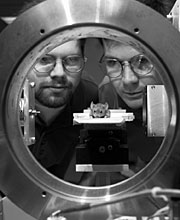 |
|---|
Mike Paulus (right) and UT graduate student Kevin Behel scan a mouse using MicroCAT technology. |
A technology that can scan living small
animals and other biological objects has been named project of the year by the Southeastern Region of the Federal Laboratory Consortium.
The MicroCAT X-ray micro-computed tomography for biological research was named the top project in the Southeast. The FLC promotes technology commercialization among federal laboratories.
MicroCAT technology enables mice and other small creatures to be screened for tumors and genetic study while they are alive. It provides three-dimensional images and saves time and money because biologists can quickly screen subjects for internal mutations without sacrificing and dissecting the animals. It also can be used to conduce cell research.
The technology was developed by Shaun Gleason and Michael Paulus of Engineering Science and Technology. Other team members are Derek Austin, Miljko Bobrek, Gary Alley, Kenneth Tobin and Chris McKinney of the division.
Two other ORNL technologies — the AquaSentinel real-time water supply protection monitor and the photo-molecular comb biomolecular separator — earned Excellence in Technology Transfer Awards.
 |
|---|
Eli Greenbaum, Charlene Sanders and Miguel Rodriguez have worked to develop the AquaSentinel water supply protection monitor. |
The AquaSentinel system was developed as real-time in-the-field detection technology for water testing and for safeguarding large-scale domestic drinking water supplies. The availability of such systems will help ensure the safety of U. S. water supply systems.
ORNL staff members involved with the project have included Elias Greenbaum, Miguel Rodriguez and Charlene Sanders of Chemical Sciences; David Hill of Metals and Ceramics; Richard Stouder of the National Security Directorate; Mark Reeves of the Technology Transfer and Economic Development Directorate; and Jack Harrell of Craft Resources.
The photo-molecular comb technology uses a light-induced charge on a semiconductor liquid interface to transport biological molecules on the surface of a microchip, illuminating the semiconductor with a low-cost light source. This results in fast, accurate biomolecular separations.
The project is a joint effort with Protein Discovery. ORNL staff members on the project are Thomas Thundat and Thomas Ferrell, Life Sciences; Gilbert Brown, Chemical Sciences; Robert Warmack, Engineering Science and Technology; and Russ Miller, Technnology Transfer and Economic Development.
Earning honorable mention for excellence in technology transfer were the MicroTrap MS microscale ion-trap mass spectrometer and the miniature californium-252 neutron source for cancer therapy.
The microtrap mass spectrometer is a microscale ion trap device that can analyze the composition of a substance through miniature chemical sensing technology. A battery-powered hand-held prototype has been constructed. ORNL researcher William Whitten of Chemical Sciences has worked on this project, along with Protasis staff.
The miniature californium-252 neutron source for cancer therapy will enable physicians to insert a tiny radiation source through a catheter, delivering high-intensity neutron radiation directly to a tumor site with more impact than existing technology. The technology was developed by Rodger Martin of Metals and Ceramics, Ian Gross of Nuclear Science and Technology, Larry Pierce of the Facilities and Operations Directorate, Mark Reeves, Russ Miller and Isotron staff members.—Fred Strohl
 ORNL People
ORNL People
Computer and Network Security’s Mark Floyd has completed the requirements of Encase Certified Examiner. EnCE certification is recognized by both the law enforcement and corporate communities as a symbol of in-depth computer forensics knowledge and illustrates that an investigator is a skilled computer examiner.
Two ORNL staff members have been elected to office in the National Property Management Association. Lab Property Manager Cheri Cross was elected to a second two-year term as NPMA executive vice president. She will provide guidance and recommendations to the 13-member executive board and oversee NPMA’s strategic and business plans. Marcia Whitson, ORNL Excessing & Property Sales manager, was elected to a two-year term as vice president of certification for the association. Whitson will be responsible for overseeing and promoting NPMA’s certification program as the acknowledged standard for property management professionals.
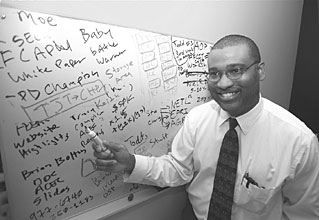 |
|---|
|
|
Janel Ellison of Audit and Management Services recently passed the Certified Information Systems Auditor exam and is now a Certified Information Systems auditor. Since 1978, the CISA program has been the globally accepted standard of achievement in the information systems audit, control and security field. Earning the CISA designation helps assure a positive reputation as a qualified security professional.
The Engineering Science and Technology Division’s Johney B. Green Jr. has been recognized as one of the “50 Most Important Blacks in Research Science” for 2004, based on his contributions to automotive research and for his highly visible role as a minority scientist and as a role model to students and others. The “50 Most Important” were featured in the September edition of Science Spectrum magazine. Green is leader of the Fuels, Engines, and Emissions Research Group in ESTD.
 |
|---|
Amit Goyal, a team leader in ORNL’s superconductivity project and a member of the Metals and Ceramics Division, has been invited to join the Executive Editorial Board (which includes only four members internationally) for the creation of a comprehensive Encyclopedia of Superconductivity, to be published by John Wiley & Sons. Key functions of the executive editorial board are to appoint an international advisory editorial board, formulate the table of contents for the encyclopedia volumes and invite appropriate contributors worldwide to provide input.
Facilities and Operations Directorate Central Complex Facility Manager Greg Palko has been named to the new position of energy efficiency manager for the Facilities Division, reporting to Jimmy Stone. Teresa Baer and Steffon Riser have accepted positions as complex facility managers, with Baer serving as CFM for the Central Complex and Riser assigned as CFM for the East Complex. Citing ORNL’s long tradition of leadership in energy management, including the recent LEED certification of the new privately funded buildings, as well as the facilities revitalization efforts to move from older buildings into new buildings, which are more energy efficient, Stone said Palko’s new role includes both revitalization efforts aimed at the laboratory’s aging infrastructure and implementation within the upcoming new facilities. Stone added that both Baer and Riser have worked in FMD for the past several years and bring valuable experience to their new positions.
Bryan Chakoumakos of the Condensed Matter Sciences Division served as guest editor for the August/September issue of American Mineralogist. The special issue was devoted to Clathrate Hydrate research, included 17 papers on the subject and featured two contributions from the ORNL Gas Hydrates Research Group.
 New Staff Members
New Staff Members
ORNL continues to grow. This feature lists new employees at the laboratory. Welcome to all.
Canajoharia Ross, Business & Information Services Directorate
Mark Tuttle, Computational Sciences & Engineering
Ryan Bennink, Computer Science & Mathematics
Martin Aslinger and Brent Massey, Craft Resources
Kevin Edwards, Engineering Science & Technology
Jennifer Baker, Environment, Safety, Health & Quality Directorate
Diane Maddox and Carolyn Waugh, Environmental Protection & Waste Services
Ashli Clark, Zhao Ping Lu, Kathleen Palmer and Michael Trammell, Metals & Ceramics
Douglas Keener, Nonreactor Nuclear Facilities
Danut Ilas, Joel McDuffe, Chris Pickett and Gomez Wright, Nuclear Science & Technology
Amy Massey, Records, Training & SBMS Services
Zafer Kursun and Louis Rupp, SNS Accelerator Systems
 Former director Herman Postma leaves enduring legacy
Former director Herman Postma leaves enduring legacy

|
|---|
| Postma had gotten into the spirit of the occasion with his ’40s-style fedora at last year’s ORNL 60th Anniversary event.
|
Herman
Postma, former ORNL director and long-time Oak Ridge community leader, died Nov. 7 while vacationing with his wife, Pat, and friends in Hawaii.
Postma became ORNL director in 1974 at age 40 — the first lab director without direct ties to the Manhattan Project. His main research background was in fusion, and he is credited with key developments in plasma heating and stability.
His 14-year tenure as director began as ORNL programs were transitioning from an emphasis on fission research to a broader energy portfolio. During his term, the Atomic Energy Commission begat the Energy Research and Development Agency, which became DOE. The national labs also began to expand their work for other federal agencies.
Postma’s term as director also saw the establishment or strengthening of ORNL ties with the University of Tennessee and relationships with partner universities, including the formation of the ORNL/UT
Distinguished Scientist Program and the lab’s first joint institute
.
 |
|---|
|
During a 1974 visit, Postma hosted Governor Winfield Dunn (center) and Roger Hibbs, Union Carbide Nuclear Division president. |
Postma, who was born of Dutch parents in Wilmington, N. C., attended Duke and Harvard universities. He spent summers from 1954 to 1957 working in ORNL’s Electronuclear and Physics divisions and joined the laboratory staff in 1959.
After his term as ORNL director, Postma became a senior vice president of Martin Marietta Energy Systems and retired in 1992.
He remained active in retirement, even though he suffered with a rare form of muscular dystrophy for years. Postma traveled frequently, served as a member of the Duke University Board of Trustees, and recently agreed to serve with Pat as fund-raising cochairs for the Oak Ridge Education Foundation’s efforts to raise $12 million to support the construction of a new Oak Ridge High School facility and other activities. Half of that goal has been reached, and a formal campaign is set to begin in January.
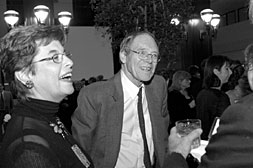 |
|---|
|
Postma and his wife, Pat, enjoyed the company at the 2003 ORNL Awards Night dinner. |
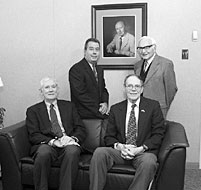 |
|---|
|
Postma and other ORNL directors Al Trivelpiece (lower left), Bill Madia and Alvin Weinberg met for a 2002 event recognizing the late Eugene Wigner. |
In addition to his wife, he is survived by his mother, Sophia, who lives in North Carolina; son and daughter-in-law, Peter and Ginnett Postma, and daughter and son-in-law, Pamela and Phillip Khinda, who all live in the Washington D.C. area; and two grandchildren, Matthew and Tommy Khinda.
Hundreds attended a Nov. 12 memorial service in the auditorium of the American Museum of Science & Energy, where Postma had conducted so many State of the Lab addresses. His family has requested that any memorials be made to the Oak Ridge Public School Education Foundation, 130 Badger Ave., Oak Ridge, 37830.
The lab and the Oak Ridge community have lost a kind friend, a wonderful leader and an enthusiastic supporter. He will be greatly missed and most certainly not forgotten.
Cindy Lundy, editor, ORNL, 865/574-1642 (lundycr@ornl.gov)
Deborah Barnes, associate editor, 865/576-0470 (barnesds@ornl.gov)
ORNL office: P.O. Box 2008, Oak Ridge, TN 37831-6146, Building 4500-S, Room F-60, MS 6146
News Deadlines
DOE inspector general hotline: 1-800-541-1625
[an error occurred while processing this directive] [an error occurred while processing this directive]
